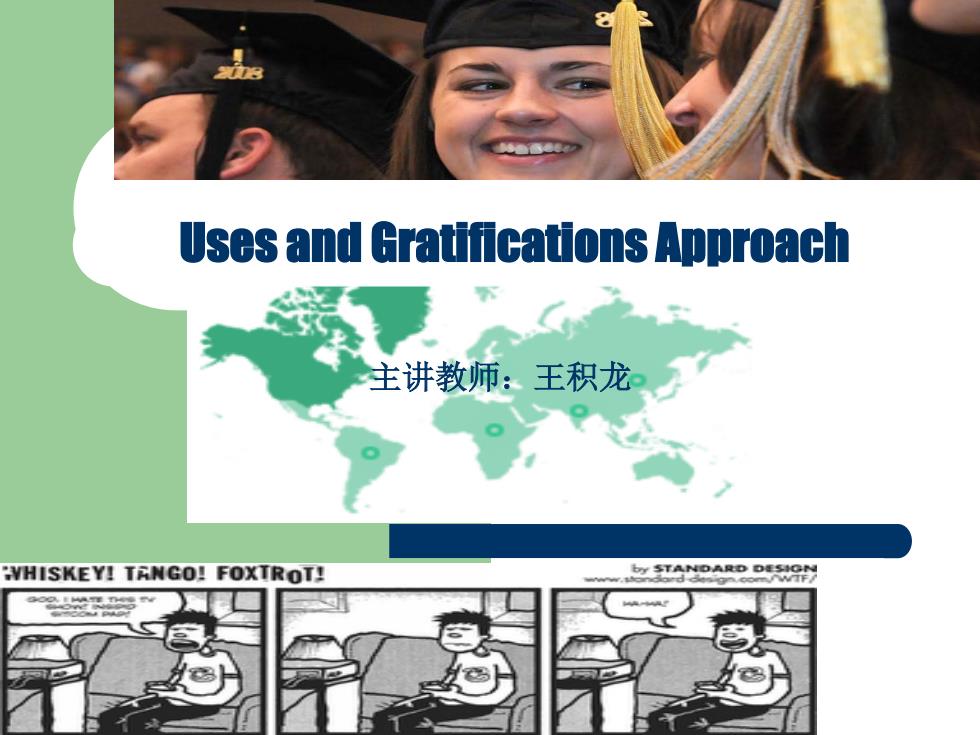
Uses and Gratifications Approach 主讲教师:王积龙 WHISKEY!TANGO!FOXTROT! 女A0ARDp59
Uses and Gratifications Approach 主讲教师:王积龙
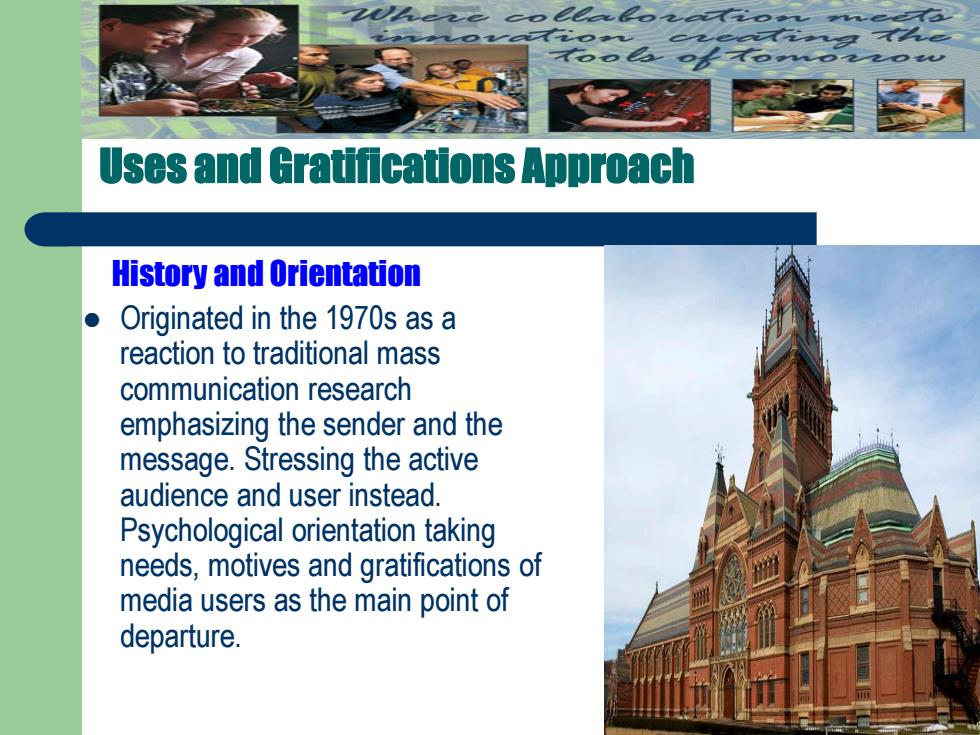
Uses and Gratifics History and Orientation ● Originated in the 1970s as a reaction to traditional mass communication research emphasizing the sender and the message.Stressing the active audience and user instead Psychological orientation taking needs,motives and gratifications of media users as the main point of departure
Uses and Gratifications Approach History and Orientation Originated in the 1970s as a reaction to traditional mass communication research emphasizing the sender and the message. Stressing the active audience and user instead. Psychological orientation taking needs, motives and gratifications of media users as the main point of departure
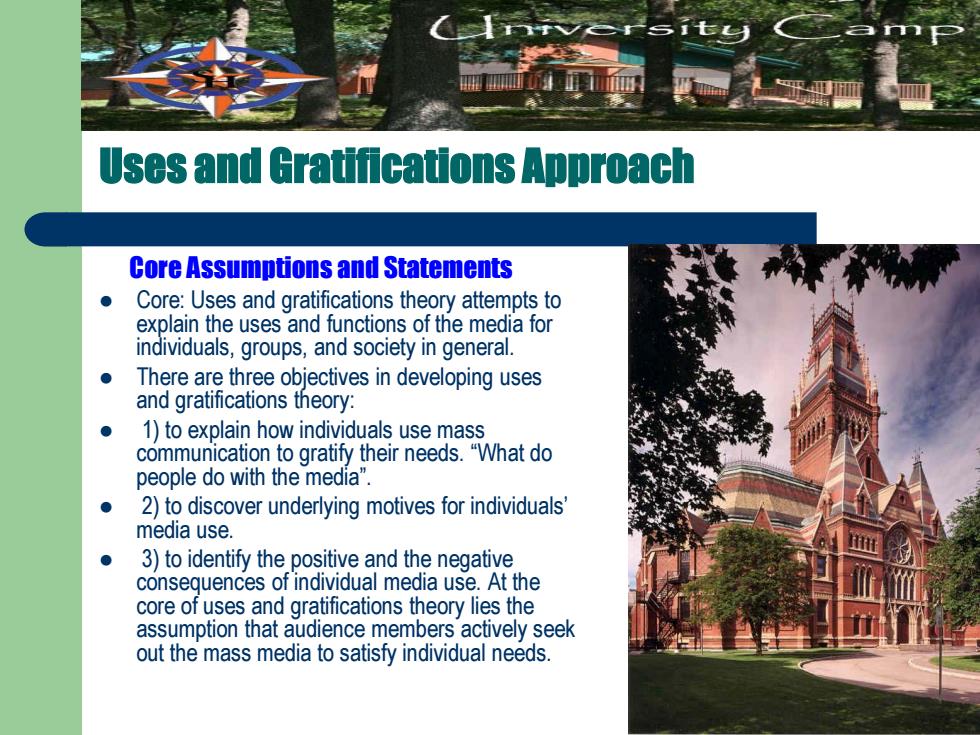
Uses and Gratifications Approach Core Assumptions and Statements Core:Uses and gratifications theory attempts to explain the uses and functions of the media for individuals,groups,and society in general. There are three objectives in developing uses and gratifications theory: 1)to explain how individuals use mass communication to gratify their needs."What do people do with the media". ● 2)to discover underlying motives for individuals media use. 3)to identify the positive and the negative consequences of individual media use.At the core of uses and gratifications theory lies the assumption that audience members actively seek out the mass media to satisfy individual needs
Uses and Gratifications Approach Core Assumptions and Statements Core: Uses and gratifications theory attempts to explain the uses and functions of the media for individuals, groups, and society in general. There are three objectives in developing uses and gratifications theory: 1) to explain how individuals use mass communication to gratify their needs. “What do people do with the media”. 2) to discover underlying motives for individuals’ media use. 3) to identify the positive and the negative consequences of individual media use. At the core of uses and gratifications theory lies the assumption that audience members actively seek out the mass media to satisfy individual needs
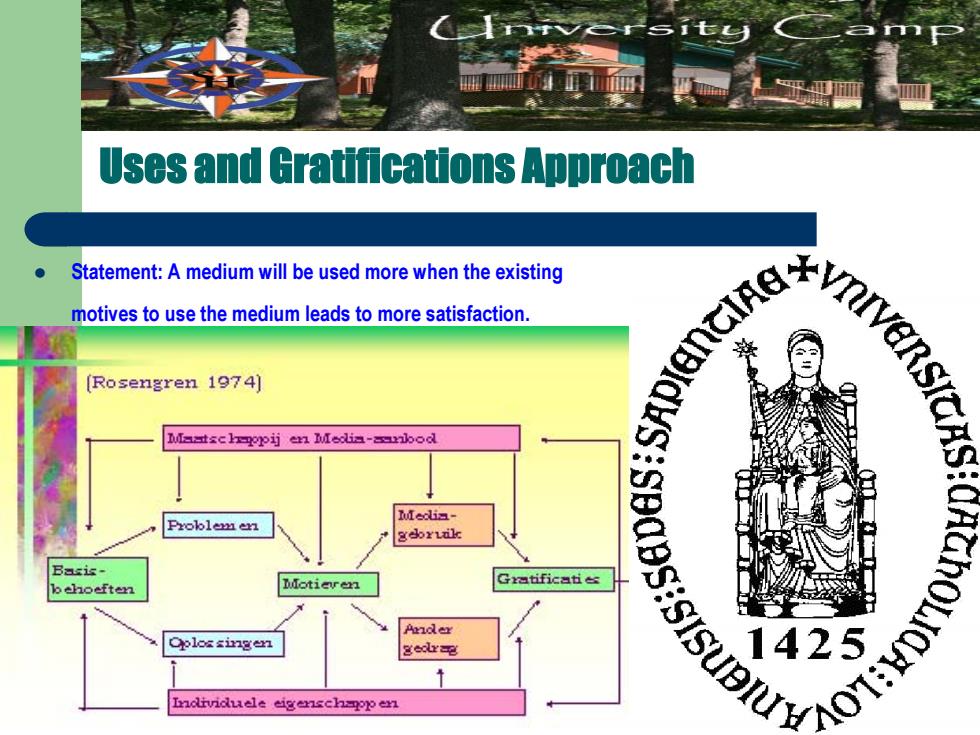
Uses and Gratifications Statement:A medium will be used more when the existing motives to use the medium leads to more satisfaction. (Rosengren 1974] Mamtschmppij en Media-snbod Mfedis- Problem en gerudle Basis- behoeften Motieren Gratificatie Ander C Oploc singen gedrag 1425 Individuele eigenschaop en
Uses and Gratifications Approach Statement: A medium will be used more when the existing motives to use the medium leads to more satisfaction

Uses and Gratifications Figure 1.A Model of Attitude toward the Web e Mad Modt Sotte b fess Prrs Surk U&G Antecedents Altitude toward the Web Consequences Entertainment Web Usage Attitude Informativeness 242 toward the Web Satisfaction Irritation
Uses and Gratifications Approach Figure 1. A Model of Attitude toward the Web
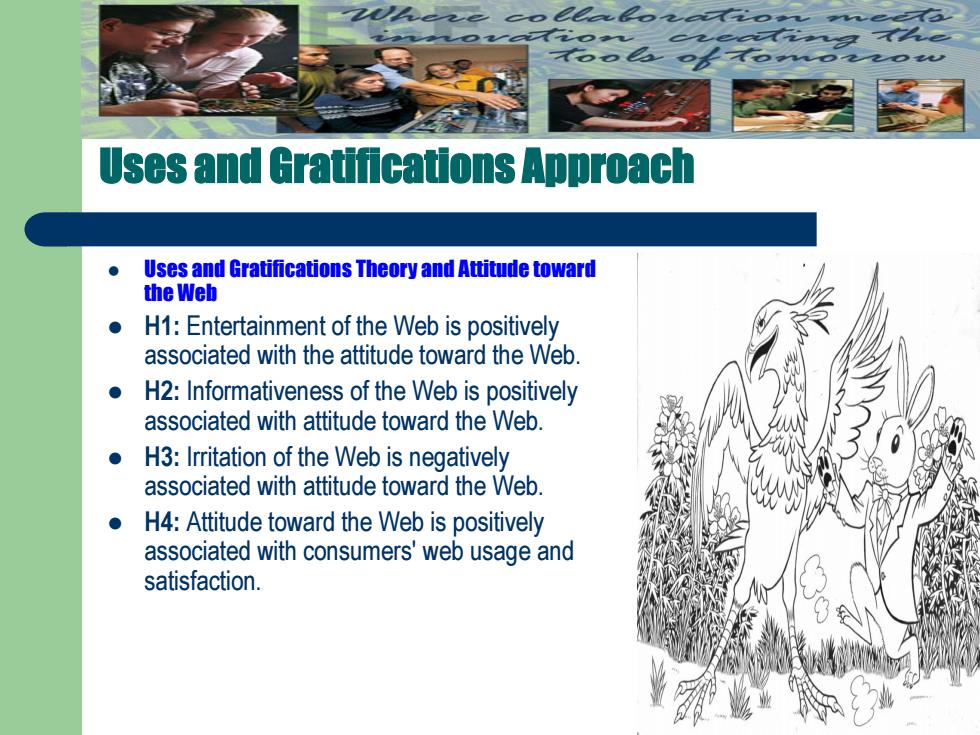
Uses and Gratifica Uses and Gratifications Theory and Attitude toward the Web ● H1:Entertainment of the Web is positively associated with the attitude toward the Web. H2:Informativeness of the Web is positively associated with attitude toward the Web ● H3:Irritation of the Web is negatively associated with attitude toward the Web ● H4:Attitude toward the Web is positively associated with consumers'web usage and satisfaction
Uses and Gratifications Approach Uses and Gratifications Theory and Attitude toward the Web H1: Entertainment of the Web is positively associated with the attitude toward the Web. H2: Informativeness of the Web is positively associated with attitude toward the Web. H3: Irritation of the Web is negatively associated with attitude toward the Web. H4: Attitude toward the Web is positively associated with consumers' web usage and satisfaction
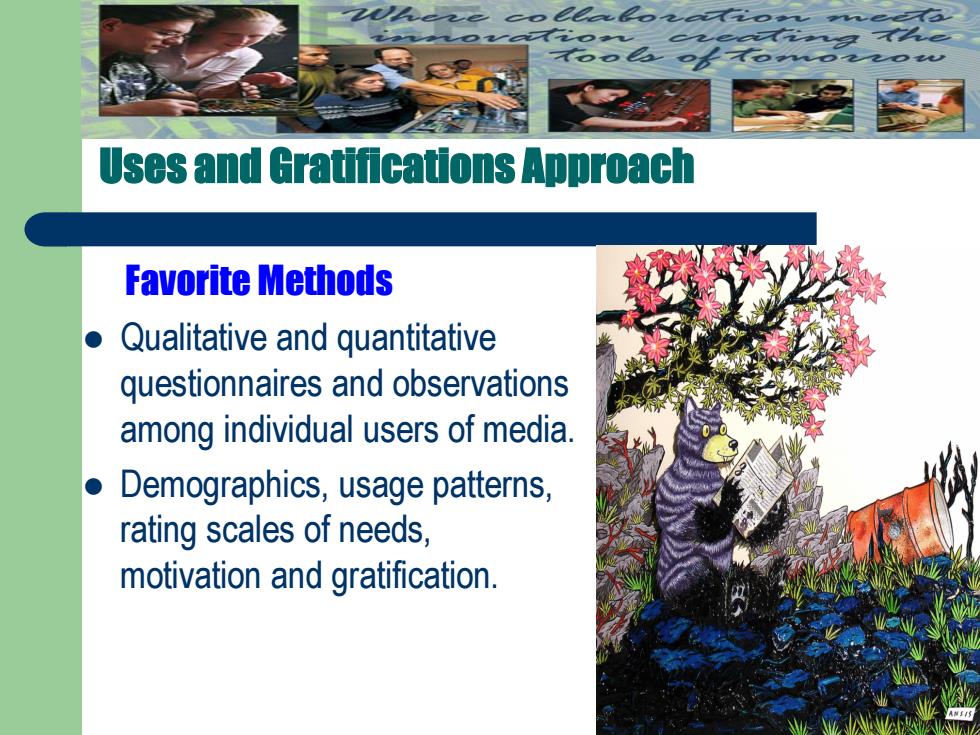
ses and Gratitication Favorite Methods Qualitative and quantitative questionnaires and observations among individual users of media. Demographics,usage patterns, rating scales of needs, motivation and gratification
Uses and Gratifications Approach Favorite Methods Qualitative and quantitative questionnaires and observations among individual users of media. Demographics, usage patterns, rating scales of needs, motivation and gratification
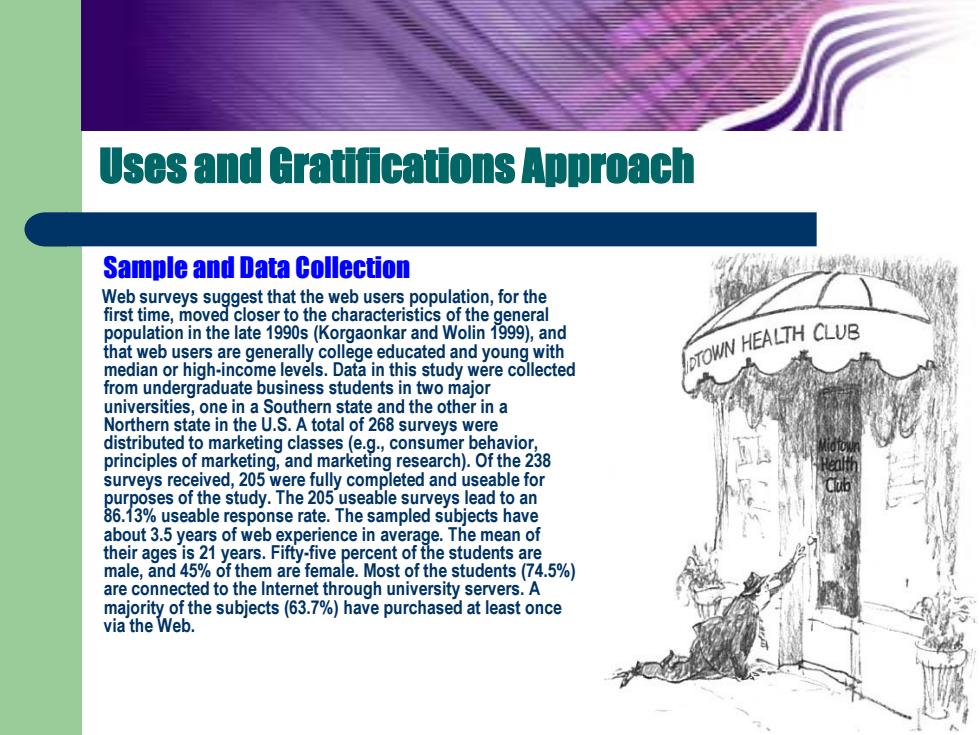
Uses and Gratifications Approach Sample and Data Collection Web surveys suggest that the web users population,for the first time,moved closer to the characteristics of the general population in the late 1990s(Korgaonkar and Wolin 1999),and that web users are generally college educated and young with TOWN HEALTH CLUB median or high-income levels.Data in this study were collected from undergraduate business students in two major universities,one in a Southern state and the other in a Northern state in the U.S.A total of 268 surveys were distributed to marketing classes (e.g.,consumer behavior, principles of marketing,and marketing research).Of the 238 surveys received,205 were fully completed and useable for purposes of the study.The 205 useable surveys lead to an 86.13%useable response rate.The sampled subjects have about 3.5 years of web experience in average.The mean of their ages is 21 years.Fifty-five percent of the students are male,and 45%of them are female.Most of the students(74.5%) are connected to the Internet through university servers.A majority of the subjects(63.7%)have purchased at least once via the Web
Uses and Gratifications Approach Sample and Data Collection Web surveys suggest that the web users population, for the first time, moved closer to the characteristics of the general population in the late 1990s (Korgaonkar and Wolin 1999), and that web users are generally college educated and young with median or high-income levels. Data in this study were collected from undergraduate business students in two major universities, one in a Southern state and the other in a Northern state in the U.S. A total of 268 surveys were distributed to marketing classes (e.g., consumer behavior, principles of marketing, and marketing research). Of the 238 surveys received, 205 were fully completed and useable for purposes of the study. The 205 useable surveys lead to an 86.13% useable response rate. The sampled subjects have about 3.5 years of web experience in average. The mean of their ages is 21 years. Fifty-five percent of the students are male, and 45% of them are female. Most of the students (74.5%) are connected to the Internet through university servers. A majority of the subjects (63.7%) have purchased at least once via the Web

ses and Grati ach Scope and Application Scope:the acceptance and use of new and old media and media content according to the needs of the users/receivers. Application:all users and receivers research;adopting innovations
Uses and Gratifications Approach Scope and Application Scope: the acceptance and use of new and old media and media content according to the needs of the users/receivers. Application: all users and receivers research; adopting innovations
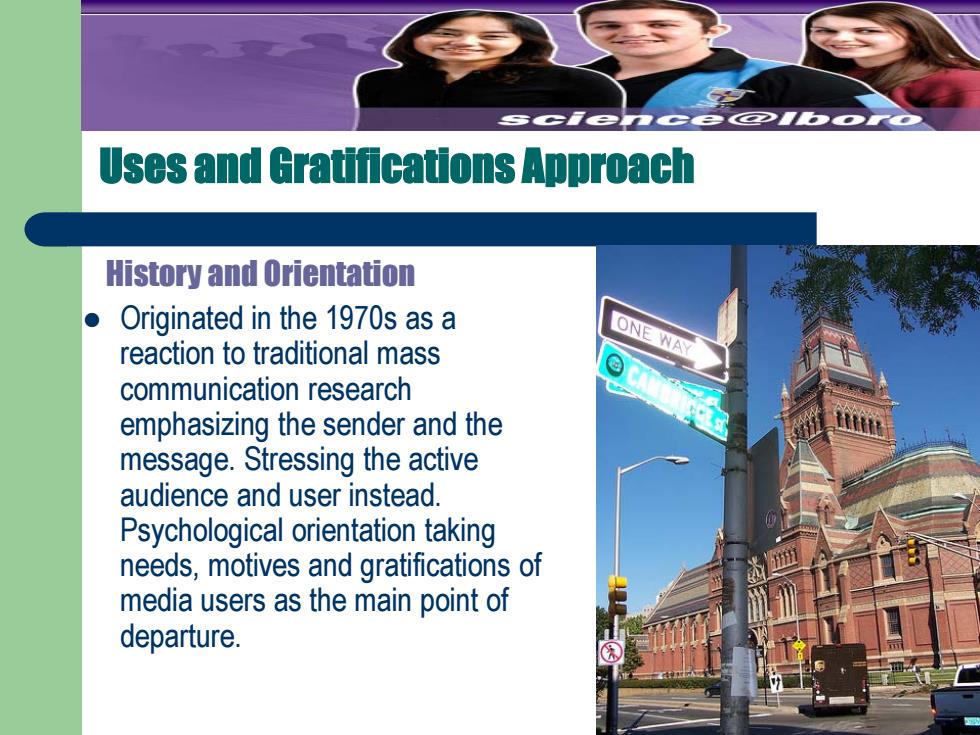
Uses and Gratifications Approach History and Orientation ● Originated in the 1970s as a reaction to traditional mass ONE WAY communication research emphasizing the sender and the message.Stressing the active audience and user instead Psychological orientation taking needs,motives and gratifications of media users as the main point of departure
Uses and Gratifications Approach History and Orientation Originated in the 1970s as a reaction to traditional mass communication research emphasizing the sender and the message. Stressing the active audience and user instead. Psychological orientation taking needs, motives and gratifications of media users as the main point of departure